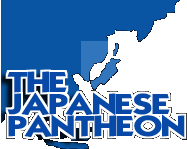 |
|
|
 |
| The
Japanese gods and goddesses are called "kami". Kami means
"highly placed being". The Japanese give the rank of kami
to natural items such as mountains, rivers, ancient trees,
and |
 |
| certain
stones, as well as to animals and great human beings. Kami
have human-type bodies and human qualities and defects. Like
humans, kami are driven by feelings such as love, hatred,
and |
|
|
|
jealousy.
However, even though kami
have these human qualities, they are very powerful and have control
over nature. There are heavenly and earthly kami: the heavenly kami
are somehow superior to their earthly counterparts.
|
 |
 |
AJI-SUKI-TAKA-HI-KONE
was one of several thunder gods. He was born noisy and grew
up even noisier, and so they had to carry him up and down a ladder
to quiet him. That is why you can hear him coming and going. |
 |
AMA-NO-UZUME
was the fertility goddess. |
 |
AMATERASU
was the sun goddess, ruler of the heavens. |
 |
AMATSU
MIKABOSHI was the god of evil. |
 |
BENZAITEN
was the goddess of love, and one of the gods of happiness.
Benzaiten rides a dragon while playing a stringed instrument. |
 |
BISHAMON
was the god of both happiness and war. Bishamon protects men from
disease and demons. Bishamon was often portrayed wearing a wheel
of fire like a halo, which some see as the Wheel of Fate. |
 |
CHlMATA-NO-KAMI
was the god of crossroads, highways and footpaths. Originally
a phallic god, his phallic symbol was placed at crossroads. |
 |
HO-MASUBI
was the fire god. His birth killed the creator goddess Izanami.
In one version of the creation, his father, the creator god Izanagi,
was so enraged with grief that he killed the baby. From his blood
came eight gods, and from the body came eight mountain gods. |
|
 |
 |
IZANAGI
and IZANAMI were the creator gods sent down from heaven to
create the earth. The other gods and goddesses are their descendants,
but when the god of fire was born he burned his mother to death.
In certain versions of the creation story, Izanami became old and
ugly as she descended to the underworld. Her husband, Izanagi, followed
her to bring her back, but she forbade him to look at her. Izanagi
looked anyway and this made Izanami so angry that she tried to imprison
him in the underworld. Pursued by Izanami's anger, Izanagi escaped
and sealed the entrance to the underworld with a boulder. Enraged,
Izanami vowed to kill a thousand of Izanagi's subjects a day, and
Izanagi vowed to create fifteen hundred a day. In this way Izanami
became the goddess of death and Izanagi the lord of life. |
 |
KAWA-NO-KAMI
was the god of the rivers. Larger rivers have their own gods,
but all waterways are under Kawa-No-Kami's authority. |
 |
NAI-NO-KAMI
was the god of earthquakes. A late addition to the Japanese
pantheon, Nai-No-Kami was introduced in the seventh century AD. |
 |
NINIGI
was the grandson god of Amaterasu, sent to rule the earth, the ancestor
of all the Japanese emperors. |
 |
O-KUNI-NUSHI
was the god of sorcery and medicine, and of the unseen world
of spirits and magic. |
 |
SENGEN-SAMA
was the goddess of the sacred mountain of Fujiyama. Worshippers
greet the rising sun at her shrine located at the top of the mountain.
|
 |
SHINE-TSU-HIKO
was the god of the wind. Shine-Tsu-Hiko fills up the empty
space between earth and heaven, and with his wife, Shina-To-Be,
he holds up the earth. |
 |
SUSA-NO-WO
was the god of storms, snakes and farming. He was Amaterasu's
brother and greatest enemy. From the moment he was born, he was
a troublemaker. For his bad deeds Susa-No-Wo was punished by the
other gods and he was banished to live as a mortal on earth.
|
|
 |
 |
|
|
| "The
Big Myth" © Distant Train 2009 |

